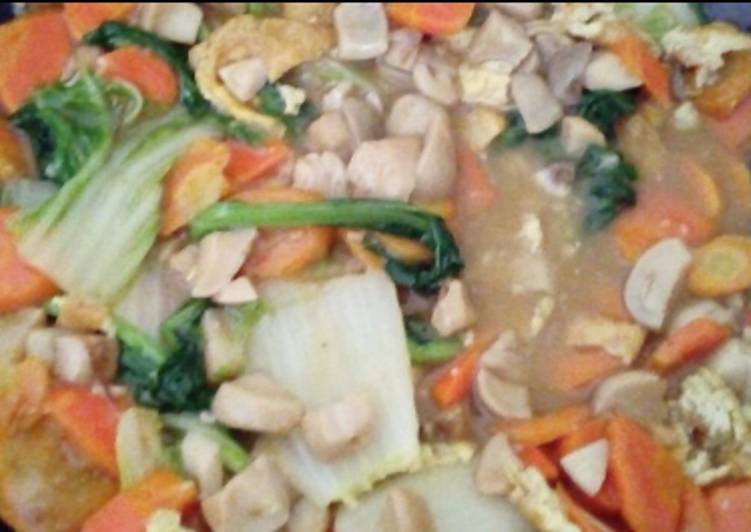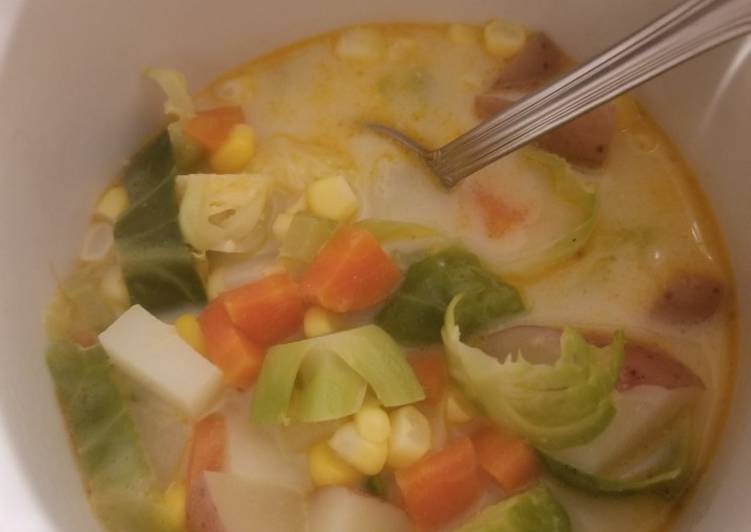
Hey everyone, hope you are having an amazing day today. Today, I will show you a way to make a distinctive dish, chap-chaai/cap cai (indonesian chinese stir fry mixed vegetables). One of my favorites food recipes. This time, I will make it a bit tasty. This will be really delicious.
Chap-Chaai/Cap Cai (Indonesian Chinese Stir Fry Mixed Vegetables) is one of the most popular of recent trending meals on earth. It is enjoyed by millions daily. It’s easy, it is quick, it tastes delicious. Chap-Chaai/Cap Cai (Indonesian Chinese Stir Fry Mixed Vegetables) is something that I have loved my entire life. They are fine and they look wonderful.
Cap cai, sometimes spelled cap cay, is the Hokkien-derived term for a popular Chinese Indonesian stir-fried vegetable dish that originates from Fujian cuisine. Various vegetables such as cauliflower, cabbage, Chinese cabbage, Napa cabbage, carrot. Cap Chay/ Indonesian Stir-fried Vegetable is a stir-fried medley vegetables with some meat and/or seafood with thick gravy.
To get started with this recipe, we must prepare a few components. You can have chap-chaai/cap cai (indonesian chinese stir fry mixed vegetables) using 14 ingredients and 9 steps. Here is how you cook that.
The ingredients needed to make Chap-Chaai/Cap Cai (Indonesian Chinese Stir Fry Mixed Vegetables):
- Get 2 carrot
- Get 2 cabbage
- Prepare 100 gram mushroom (i use button mushroom/champignon)
- Take 2 pokchoy (chinese cabbage)
- Take 1 frying beaten egg (optional)
- Take 1 garlic
- Take 1 tsp black pepper
- Make ready Sauce:
- Take 4 tbsp oyster sauce
- Prepare 1 tsp salt
- Prepare 1 tsp buillon powder (optional)
- Take 2 tbsp flour
- Get 100 ml water
- Prepare 3 tbsp vegetable oil
Cap cai sometimes spelled cap cay (Chinese: 雜菜; pinyin: zácài; Pe̍h-ōe-jī: cha̍p-chhài; literally: 'mixed vegetables') is the Hokkien-derived term for a popular Chinese Indonesian stir fried vegetable dish that originates from Fujian cuisine. Photo about Ready to serve stir fried cap cai or mixed vegetable, chinese cuisine in Indonesia. Vind stockafbeeldingen in HD voor Cap Cay Cap Cai Indonesianchinese Vegetable en miljoenen andere rechtenvrije stockfoto's, illustraties en vectoren in de Shutterstock-collectie. Elke dag worden duizenden nieuwe afbeeldingen van hoge kwaliteit toegevoegd.
Instructions to make Chap-Chaai/Cap Cai (Indonesian Chinese Stir Fry Mixed Vegetables):
- Wash all the vegetable ingredients
- Chop-chop pokcoy (chinese cabbage)
- Chop-chop cabbage
- Chop-chop carrot and mushroom
- Chop-chop fried egg
- Heat pan and add vegetable oil and garlic and black pepper. Then stir fry carrot until cooked, add mushroom inside. Then stir fry. Add chopped cabbage, chinese cabbage and egg. Stir fry
- Add salt, buillon powder, oyster sauce then stir fry again
- Put flour in a glass then add water. Then disolve the flour. Then add it in frying pan. Then Stir fry all until cooked. Then test taste if you still need salt you can add it
- Serve it. We usually serve it with rice
I am not a Peranakan so I won't dare to name this is Nonya Chap chye. But as a Hainanese, surprisingly we eat chap chye during CNY and my aunt cook it really well. So when I was given the task to prepare lunch for the family, I wanted something quick and. Trova immagini stock HD a tema Capcay Chinese Indonesian Stir Fry Vegetables e milioni di altre foto, illustrazioni e contenuti vettoriali stock royalty free nella vasta raccolta di Shutterstock. Migliaia di nuove immagini di alta qualità aggiunte ogni giorno.
So that is going to wrap it up for this special food chap-chaai/cap cai (indonesian chinese stir fry mixed vegetables) recipe. Thanks so much for reading. I am confident you can make this at home. There is gonna be more interesting food at home recipes coming up. Remember to save this page on your browser, and share it to your loved ones, colleague and friends. Thanks again for reading. Go on get cooking!


